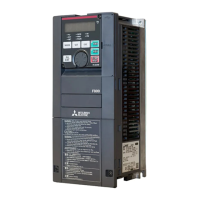609
7. PRECAUTIONS FOR MAINTENANCE AND INSPECTION
7.2 Measurement of main circuit voltages, currents and powers
3
4
5
5
5
5
7
8
9
10
7.2.1 Measurement of powers
Use digital power meters (for inverter) for the both of inverter input and output side.
7.2.2 Measurement of voltages
Inverter input side
Use a digital power meter (for inverter) on the inverter's input side.
Inverter output side
When using a measuring instrument, use a digital power meter for inverters since the inverter outputs PWM-controlled square
wave voltage. The value monitored on the operation panel is the inverter-controlled voltage itself. Monitoring values via the
operation panel or by outputting the analog signal is recommended as these values are accurate.
7.2.3 Measurement of currents
Use a digital power meter (for inverter) both on the inverter's input and output sides. Since current on the inverter input side
tends to be unbalanced, measurement of three phases is recommended. Correct value cannot be obtained by measuring only
one or two phases. On the other hand, the unbalanced ratio of each phase of the output side current should be within 10%.
The inverter output current can be monitored on the operation panel. The value monitored on the operation panel is accurate
if the output frequency varies, and it is recommended to monitor values (provide analog output) using the operation panel.
7.2.4 Measurement of inverter input power factor
Calculate using effective power and apparent power. A power-factor meter cannot indicate an exact value.
7.2.5 Measurement of converter output voltage (across
terminals P and N)
The output voltage of the converter is output across terminals P and N, and can be measured with a voltmeter such as a digital
multimeter. Although the voltage varies according to the power supply voltage, approximately 800 VDC to 900 VDC is output
when no load is connected and voltage decreases during driving load operation.
When energy is regenerated from the motor during deceleration, for example, the converter output voltage rises to nearly 1100
VDC to 1300 VDC maximum.
7.2.6 Measurement of inverter output frequency
In the initial setting, a pulse train proportional to the output frequency is output across the analog current output terminals CA
and 5 of the inverter. Measure the current using a tester.
For detailed specifications of the analog current output terminal CA, refer to page 288.
Total power factor of the inverter =
Effective power
Apparent power
=
Three-phase input power found by the 3-wattmeter method
3×V (power supply voltage) × I (input current effective value)
√

